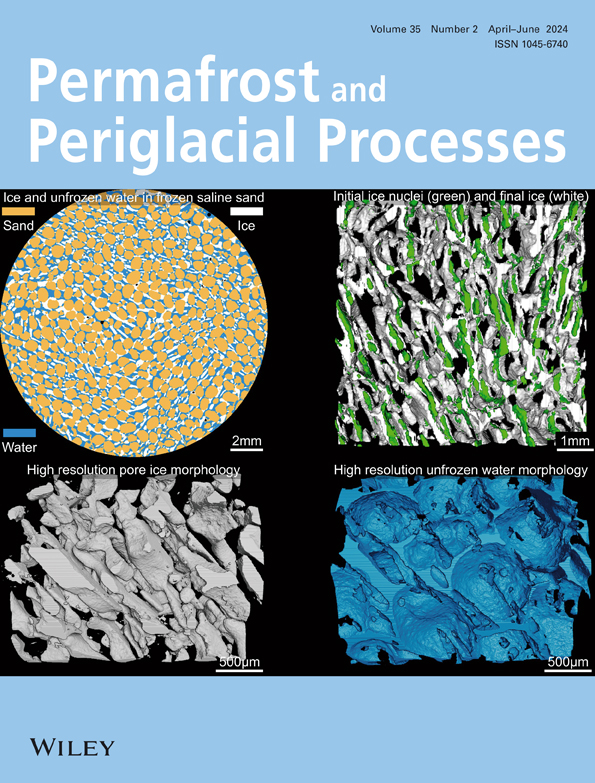近地表土壤温度和活动层厚度的景观尺度变化:对高分辨率永久冻土制图的影响
IF 3.3
3区 地球科学
Q2 GEOGRAPHY, PHYSICAL
引用次数: 10
摘要
永久冻土区的土壤温度观测很少,这限制了我们对高空间分辨率永久冻土区条件的理解和能力。在这项研究中,我们于2016年8月至2017年8月在加拿大西北部北部寒带和苔原地区的107个地点测量了近地表土壤温度(Tnss)。同时还测量了这些站点的活性层厚度(ALT)、土壤和植被状况。我们的观测表明,在气候相似的地区,tss和ALT的变化很大。这种高度的空间异质性说明了高分辨率永久冻土制图对基础设施规划和了解永久冻土融化影响的重要性。各观测点的年平均气温变化幅度为5 ~ 6℃,这主要是由于冬季和春季气温的差异造成的,这表明降雪条件对近地表地表温度景观尺度变化的重要性。ALT从约30厘米到超过120厘米不等。不同站点间ALT的变化与融化季节长度无关,但与土壤条件的变化有关,特别是表层有机层厚度。冻融因子在不同地点和不同生态型之间存在显著差异,而除裸地外,冻融因子在不同地点之间相似。研究表明,生态类型可用于冻土带地区景观尺度上的ALT和Tnss地图绘制,但在北方寒带地区效果不佳。本文章由计算机程序翻译,如有差异,请以英文原文为准。
Landscape‐scale variations in near‐surface soil temperature and active‐layer thickness: Implications for high‐resolution permafrost mapping
Soil temperature observations in permafrost regions are sparse, which limits our understanding and ability to map permafrost conditions at high spatial resolutions. In this study, we measured near‐surface soil temperatures (Tnss) at 107 sites from August 2016 to August 2017 in northern boreal and tundra areas in northwestern Canada. Active‐layer thickness (ALT), soil and vegetation conditions were also measured at these sites. Our observations show large variations in Tnss and ALT across an area with a similar climate. This high degree of spatial heterogeneity illustrates the importance of high‐resolution mapping of permafrost for infrastructure planning and understanding the impacts of permafrost thaw. Annual mean Tnss varied by 5–6°C among observation sites, which was mainly due to differences in Tnss in winter and spring, indicating the importance of snow conditions on determining landscape‐scale variation in near‐surface ground temperatures. ALT varied from about 30 cm to more than 120 cm. The variation in ALT among sites did not correlate with thawing season Tnss, but was associated with variation in soil conditions, especially the surface organic layer thickness. Freezing n‐factors varied significantly from site to site and among ecotypes, while thawing n‐factors were similar among sites, except bare soils. This study shows that ecotypes can be used to map ALT and Tnss at landscape scales in tundra areas, but the method is not as effective in the northern boreal region.
求助全文
通过发布文献求助,成功后即可免费获取论文全文。
去求助
来源期刊
CiteScore
9.70
自引率
8.00%
发文量
43
审稿时长
>12 weeks
期刊介绍:
Permafrost and Periglacial Processes is an international journal dedicated to the rapid publication of scientific and technical papers concerned with earth surface cryogenic processes, landforms and sediments present in a variety of (Sub) Arctic, Antarctic and High Mountain environments. It provides an efficient vehicle of communication amongst those with an interest in the cold, non-glacial geosciences. The focus is on (1) original research based on geomorphological, hydrological, sedimentological, geotechnical and engineering aspects of these areas and (2) original research carried out upon relict features where the objective has been to reconstruct the nature of the processes and/or palaeoenvironments which gave rise to these features, as opposed to purely stratigraphical considerations. The journal also publishes short communications, reviews, discussions and book reviews. The high scientific standard, interdisciplinary character and worldwide representation of PPP are maintained by regional editorial support and a rigorous refereeing system.

 求助内容:
求助内容: 应助结果提醒方式:
应助结果提醒方式:


